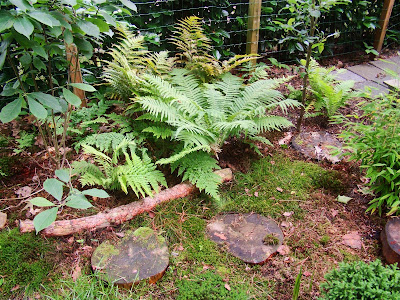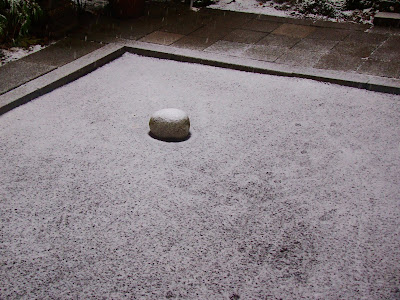Kikiyaya Forest Dwelling and Zen Garden have changed a lot in the past year. The small 35 sq.m. bungalow now looks like a luxurious Tokyo compact penthouse, while the garden has become more mature. As I had no initial design for the garden when I started this project in the spring of 2012, I kept adding and changing features as I went along until it looked or felt right. However, I feel I am not going to change the basic design of the garden as it is now.
Since the summer of 2012 I have changed the type of gravel from an expensive light coloured Japanese gravel to a cheap 1-3 mm black (when wet) light grey (when dry) gravel used in construction (invoegsplit 4 Euro per 20 kg bag at the Gamma or Praxis!) Its excellent properties allow me to create beautiful designs with my cheap handmade rake. In the evening or when it rains it turns black, and during the day it becomes light grey. When the gravel is in the process of drying it turns into this gorgeous multi-monochromatic black/grey colour pattern. Also, when the sun shines onto the black moist gravel, it heats up so much that it creates a damp sub-tropical atmosphere into my well protected garden, raising the temperature by a few degrees.
The fine gravel becomes rather compact after a while and this makes it fairly easy to clean it with a broom. I clear out the rubbish with this Ikea sieve.
Bare in mind that the dry garden is right underneath a huge oak tree as well as a pine needle tree. With the slightest breeze, needles, leaves and/or pollen as well as bird and squirrel poopies rains down onto the gravel, no matter what time of year, thus I need to clean it up every day. The zen garden is only perfect for a few minutes, perhaps a few hours a day during high summer when I plan to take photos or video. One lesson learned: never create a dry garden underneath a tree!
In September 2012, I also added a veranda to the bungalow in order to double the size of the bungalow's living area. Initially, I wanted to create an authentic Japanese room with real tatami mats and shoji doors, however, local building regulations at the bungalow park requires me to give the veranda an open character, so I am not allowed to put in Japanese sliding doors. This makes it impossible to protect the tatami from getting wet so I resorted to cheap tatami-look-a-like mats sponsored by Ikea. The Japanese table is by Ikea too. Actually this fits in well with my "religion" to keep things nice and cheap like my impressive pagodas that I created from my neighbour's discarded patio tiles. The Buddha I found in a local dump next to a bag with kitty-litter.
As the garden doesn't receive much direct sunlight, the moss in the paradise garden remains fine. I "borrowed" or rather "transplanted" the moss from the surrounding forest. This forest acts perfectly as Kikiyaya's borrowed landscape! But it also makes it very messy. Also, this year I started creating an azalea/rhododendron garden at the back of the bungalow. It receives a bit more sunlight than the dry rock and moss garden at the front or veranda-side of the bungalow.
White expensive gravel in the Japanese-style rain gutter.
The moss garden with Mount Kikiyaya at the back. Its summit is at about 1 meter.
Mount Kikiyaya used to have moss growing on it, however, some birds used to dig it up and destroy it so I planted it with leptinella potentilina.
Two types of moss.
Mount Kikiyaya started off as a compost heap near the back entrance of the garden.
Japanese room by Ikea.
My dog, English Bull Terrier: Harry Chan, but I sometimes call him
Barbra Streisand (because of the nose).
Harry loves Kikiyaya too. He has seen me creating the garden and
he understands that this garden should not be walked on.
he understands that this garden should not be walked on.
The deep waves I create with a little hand-shovel.
I love this combination of deep curved, shallow straight
and shallow curved waves in one frame.
and shallow curved waves in one frame.
This is the only sunny area in the dry garden, thus I
needed to use leptinella potentilina instead of real moss.
Wonderful Chinese garden stools, sold to me for 20 Euros each by a fan of my garden. This English gentleman who lives further down the path thought they looked better in Kikiyaya than in his own garden!
On the left a 7 meter long mountain ridge (alt. 50 cm)
covered in real moss.
covered in real moss.
The wooden bench was donated by another neighbour.
I like to sit on it when grooming my English Bull Terrier Harry Chan.
I like to sit on it when grooming my English Bull Terrier Harry Chan.
Kikiyaya the way it looked in November 2012
Apart from Japanese cushions (by Ikea) on the floor
of the veranda for Asian-style sitting,
I also needed to install a European-style table
and chairs for western people, as many are
unable to sit on the floor!
of the veranda for Asian-style sitting,
I also needed to install a European-style table
and chairs for western people, as many are
unable to sit on the floor!
I particularly love this design with the checkered pattern.
I consider this the main gravel design of the zen garden.
The moss garden has bamboo in it, two types of moss and plenty of ferns,
an apple tree, Japanese acer, and a magnolia.
It's nothing expensive; a glass rock from Intratuin Gardencentre
The Japanese lantern is made of plastic and has a
solar light in it (from Intratuin). I will replace it
with a stone one as soon as my budget allows me to.
solar light in it (from Intratuin). I will replace it
with a stone one as soon as my budget allows me to.
The paper lanterns are from the toko Chinese shop in Utrecht.
I like this photo.
I like this photo.
The tools I use: The broomstick on the left I also use to fly over the forest.
The simple rakes I made from discarded wood from the dump. The little
shovel I use to create big waves.
At the back of the bungalow, I allotted an extra portion
of land to create a Japanese-style Azalea-
Rhododendron-garden inspired by
this The north-garden of Tofukuji Temple (photo below) in Kyoto.
Hopefully it will start looking a bit like it some time next year.
The way it looks today.
Black running bamboo. Need to keep that in check!
At the back I have some shrubs with all sorts of berries for breakfast next
to a little patch of rose bushes which I call the Barbra Streisand Rose Garden.
I love Barbra as much I as love the Dalai Lama.
BTW. Kikiyaya is the name of my imaginary kingdom near Japan:
The Kingdom of Kikiyaya Pacific Blue Archipelago.
This is the bungalow how I found it in
the spring of 2011, when I returned
the spring of 2011, when I returned
from my 11-year sojourn in Asia.





































































































